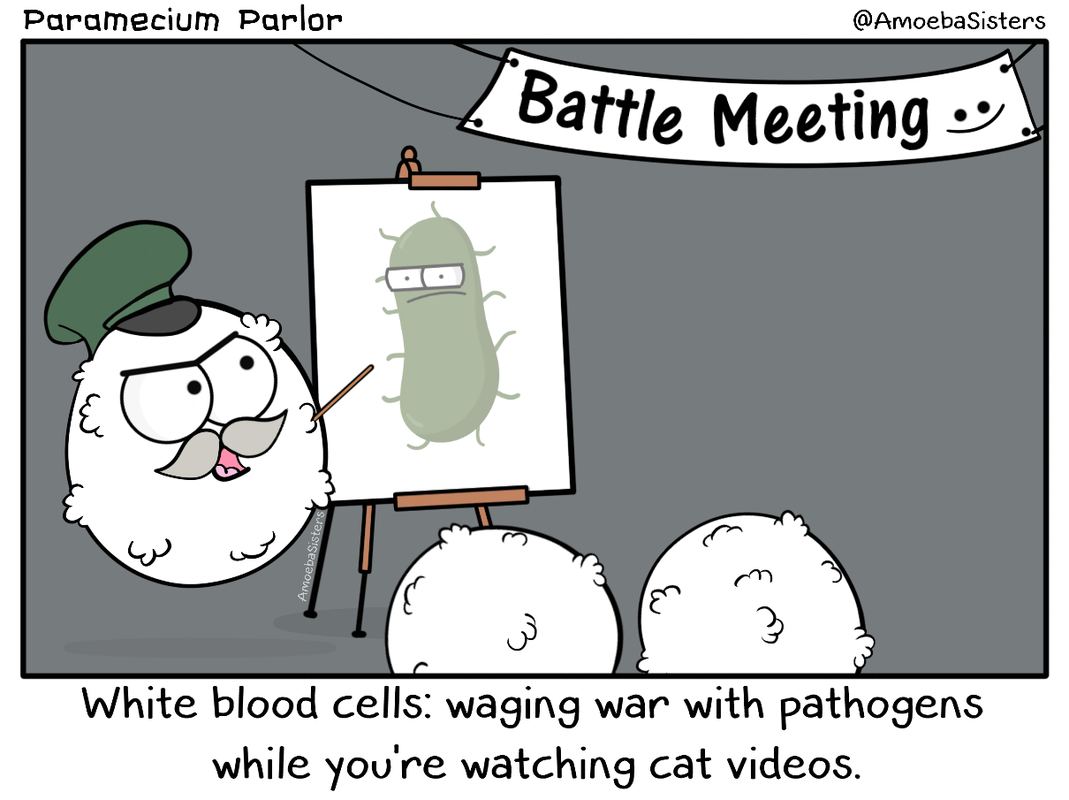Week 12: Immune System
To-Do Date: Apr 17 at 12:00pmCartoon
In this cartoon, the White Blood Cells are planning to attack a pathogen. Can you tell what type of pathogen? Which WBC is most likely to be ''pointing'' out the enemy? Which type of WBC is most likely to be in the ''audience''? How does that cartoon relate to the one below it ? ( Might want to see the original Michelangelo painting hereLinks to an external site. )


Learning Objectives
At the end of the module, students will be able
- Distinguish between bacteria and viruses
- Explain how a virus enters, takes over and leaves a cell. How does it make copies of itself?
- Identify the different cells, tissues and organs involved in immune defense and their functions.
- Organs and tissues : Lymph and lymph nodes, skin, mucus, tears, ear wax
- White Blood Cells: Phagocytic Cells, T Cells ( Helper and Cytotoxic), B Cells, ( this should include important molecules that they make such as antibodies) and memory cells.
- Non- specific immunity: Explain the intrinsic and general ( non-specific) mechanisms that protect us from pathogens and toxins
- the role of skin, mucus, ear wax, sweat, tears and microbiome
- Explain inflammation- what causes it and its benefits.
- Adaptive immunity: Explain how adaptive (specific) immunity works to protect us against pathogens.
- pathogens, antigens, phagocytosis, antigen presenting cells, Helper T-cells, B-cells, Cytotoxic T-cells, memory cells. What are the advantages and disadvantages to adaptive immunity
- Define the following vocabulary
-
Bone marrow Histamines Lymph fluid and lymph nodes Inflammation Pathogen White Blood Cell Bacteria Antigen Presenting Cell ( APC) Virus Helper T Cells Antigen Cytotoxic T Cells Antibody B cells Phagocytosis Memory Cells
-
Study Guide Questions
1. What is a virus and how does it enter a cell, replicate itself and leave a cell?
2. What is non-specific immunity? What are the different mechanisms? What type of dangers does it protect us against?
3. What is inflammation? What are the benefits and problems associated with inflammation?
You will need to include information about
-
-
- White Blood Cells
- Histamines
- Capillaries
- Blood flow.
-
4. Describe the process by which your immune system fights off the cold virus when you are first infected. What happens the second time you are infected with the same virus?
You will need to include information about:
-
-
- How pathogens like colds enter our system
- What happens with White Blood Cells and how are they converted into Antigen Presenting Cells (APC)
- What happens to those APCs in the lymph nodes
- What is the role of Helper T-cells, Cytotoxic T-cells and B- cells and antibodies
- Explanation of memory cells- how they are made, what they do and how the virus is attacked with the second infection.
-